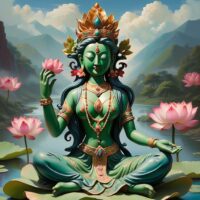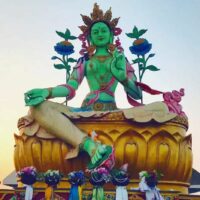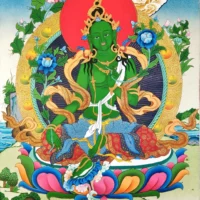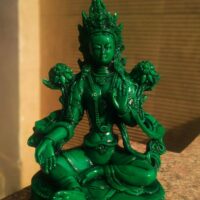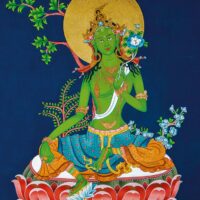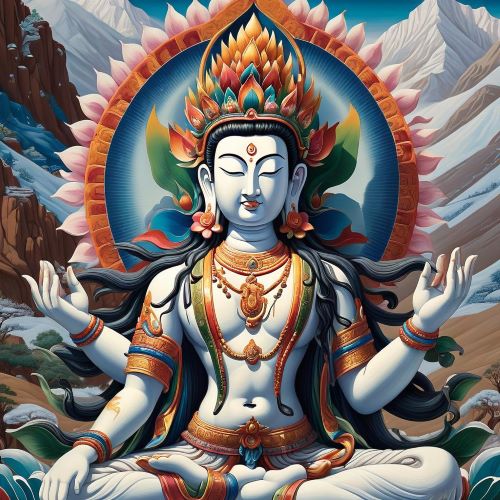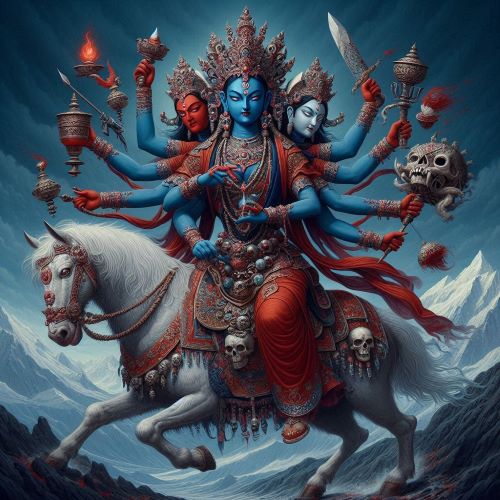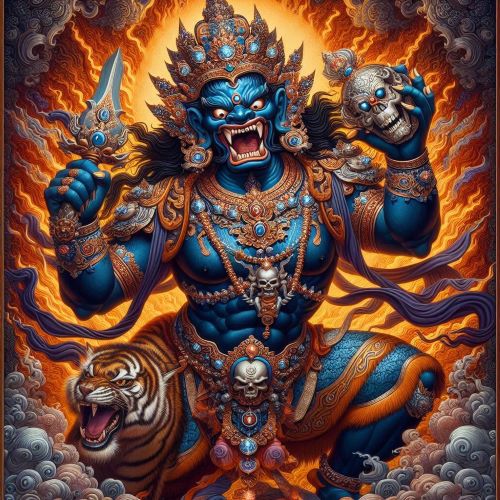Green Tara : The Compassionate One
Listen
At a glance
| Description | |
|---|---|
| Origin | Tibetan Mythology |
| Classification | Gods |
| Family Members | N/A |
| Region | Tibet, Nepal, Bhutan, India |
| Associated With | Compassion, Help |
Green Tara
Introduction
Green Tara, also known as Dölma or Sgrol-ljang in Tibetan, holds a central role in Buddhism, particularly within Vajrayana and Mahayana traditions. She is regarded as a female bodhisattva and is often depicted as the consort or shakti (power) of Avalokiteshvara. Green Tara’s significance lies in her role as a saviouress who listens to the pleas of beings trapped in saṃsāra, rescuing them from both worldly and spiritual peril.
Within Tibetan Buddhism, Green Tara embodies compassion, protection, and decisive action. She is revered as a symbol of hope and salvation, known for her benevolence and swift aid to all who seek her assistance. Green Tara’s radiant presence symbolizes compassionate enlightenment, offering solace and guidance along the path to liberation. She transcends mere deity status, embodying the essence of liberation from suffering and enlightenment.
Physical Traits
Green Tara’s iconography is a vivid representation of her compassionate and enlightened nature within Tibetan Buddhism. She is typically depicted in Lalitāsana, a posture of ease and grace, with one leg folded on a lotus seat and the other hanging down, symbolizing her readiness to assist those in need. The emerald green or “blue-green” color of her skin signifies vitality and awakened activity, reflecting her role as a compassionate saviouress. Adorned with divine ornaments and flowing green robes, Green Tara’s appearance is imbued with symbolism of renewal, growth, and her deep connection to nature.
The serene and youthful figure of Green Tara exudes compassion through her gentle yet powerful gaze, providing comfort and assurance to her devotees. Her posture, with one leg extended outward, signifies her active engagement in the world, while the folded leg represents her connection to the transcendent realm. This duality highlights her role as a bridge between the earthly and spiritual realms, embodying swift action and divine grace. Tara’s hands may hold symbolic objects like a blue utpala flower, representing spiritual potential, or a wish-fulfilling jewel, symbolizing her ability to grant wishes and dispel fears.
Green Tara’s iconography extends beyond mere physical representation to encapsulate profound spiritual teachings. Her depiction with eyes on the soles of her feet and palms of her hands symbolizes her omniscient awareness and compassionate presence in every corner of existence. Each detail in her portrayal, from her attire to her gestures, carries deep meaning, reflecting her role as a compassionate liberator and guide on the path to enlightenment. Green Tara’s imagery continues to inspire devotion and reverence, offering solace and guidance to those who seek her compassionate intervention and swift aid in times of need.
Family
According to Tibetan mythology, Green Tara is believed to have consorted with a monkey, who was an emanation of Avalokiteshvara, and together they gave birth to the Tibetan people. This myth highlights Green Tara’s profound connection to the origins of Tibetan culture and underscores her role as a nurturing and creative force. Additionally, Green Tara is said to have manifested as Princess Bhṛkutī, the Nepalese wife of King Srong Btsan Sgam Po, further emphasizing her ability to adapt and engage with earthly realms to benefit sentient beings.
In the context of Tibetan Buddhism, Green Tara is regarded as a Bodhisattva—an enlightened being who compassionately assists others on their path to enlightenment. She is closely associated with Avalokiteshvara, the Bodhisattva of compassion, and is considered his consort or emanation. This spiritual relationship signifies Green Tara’s embodiment of compassionate action and her active role in alleviating suffering and guiding beings towards liberation.
Green Tara’s familial connections within the Vajrayana pantheon are multifaceted. She is often depicted as the consort of Amoghasiddhi, the Dhyani Buddha associated with success and accomplishment. However, her significance transcends earthly bonds and family ties. Green Tara is revered as the “Mother of all Buddhas,” symbolizing the nurturing and supportive energy that guides all beings on their journey towards enlightenment. This portrayal underscores her universal compassion and her role as a divine mother figure within Tibetan Buddhist cosmology.
Other names
Green Tara is celebrated under a multitude of names that reflect her widespread fame and significance across various spiritual traditions. In Sanskrit, she is known as Shyamatara, emphasizing her dark or green color. Tibetans revere her as Sgrol-ljang, which translates to “the swift liberator,” underscoring her role as a quick and compassionate savior. Other epithets such as “The Awakened One who Saves,” “The Wish-Fulfilling Jewel,” and “The Tara of the Lotus” shed light on the diverse aspects of her compassionate nature and her ability to grant wishes and alleviate suffering.
Across different cultural and linguistic contexts, Green Tara is known by several names that capture the essence of her benevolent character. In Sanskrit, she is also referred to as Ārya Tārā, signifying her noble stature as a bodhisattva and liberator. In Tibetan, she is revered as Jetsün Dölma, meaning “venerable mother of liberation,” highlighting her role as a compassionate guide towards enlightenment. In Chinese, she is recognized as Duōluó Púsà and Dùmǔ, reflecting her universal appeal and influence beyond Tibetan Buddhism.
The diverse names attributed to Green Tara underscore the various ways in which she is venerated and invoked across spiritual practices. Whether as Shyamatara, Sgrol-ljang, or Dolma, each name carries deep significance in conveying her compassionate and protective qualities. Green Tara’s multifaceted identity resonates with devotees worldwide, symbolizing hope, salvation, and the swift response to those in need, regardless of cultural or linguistic boundaries.
Powers and Abilities
Green Tara is revered for her legendary interventions and compassionate deeds, believed to possess the extraordinary power to overcome obstacles swiftly and grant wishes to her devotees. She is a source of protection against physical and spiritual dangers, guiding individuals through life’s challenges with wisdom and grace. Devotees invoke Green Tara seeking immediate aid and comfort, relying on her responsive nature to alleviate suffering and offer solace.
Central to Green Tara’s veneration is her ability to liberate devotees from various fears, providing swift relief from eight major fears including fire, water, wild animals, thieves, imprisonment, demons, powerful enemies, and untimely death. Beyond protection, Green Tara embodies the essence of enlightened activity, fostering inner peace, promoting healing, and granting wishes aligned with spiritual growth. Meditating on her form and reciting her mantra, “Om Tare Tuttare Ture Soha,” enables practitioners to cultivate compassion, overcome obstacles, and advance swiftly on their journey toward enlightenment.
In Vajrayana Buddhism, Green Tara is regarded as a Buddha, described in the Tārā Tantra as a mother figure who gives birth to buddhas across different eras. She transcends the realms of saṃsāra and nirvāṇa, embodying compassion in action as she extends her hand from her lotus throne to assist sentient beings. Green Tara’s main mantra, “Om Tare Tuttare Ture Svaha,” holds profound significance for Buddhists and Hindus alike, symbolizing the universal appeal and transformative power of her compassionate energy.
Modern Day Influence
Green Tara’s influence spans across time and borders, resonating deeply with practitioners in the modern world. Her image graces meditation halls and private altars, serving as a constant symbol of boundless compassion and enlightened activity accessible to all beings. In our fast-paced society, Green Tara’s message of swift liberation offers solace and strength, providing a refuge from the anxieties and challenges of daily life while reminding individuals of their inherent potential for peace and wisdom.
Particularly impactful is Green Tara’s role as a powerful exemplar, especially for women, challenging conventional patriarchal structures by embodying enlightened activity rooted in wisdom and compassion. She inspires women to embrace their inner strength, develop their unique talents, and contribute meaningfully to society. Despite originating from ancient traditions, Green Tara remains a revered and influential figure today. Her compassionate energy resonates with those seeking hope and solace amidst life’s uncertainties, leading to her frequent invocation in prayers, rituals, and meditations aimed at nurturing compassion and overcoming obstacles.
Moreover, Green Tara’s influence extends beyond religious realms, serving as a symbol of empowerment and resilience for many individuals. In a world increasingly valuing compassion and healing, Green Tara’s archetype embodies the transformative power of compassion and offers unwavering support to those in need. She continues to be a popular meditation deity in Tibetan Buddhism and is revered in various Buddhist traditions, including Newar Buddhism, where she is known to aid in endeavors such as building monasteries and initiating business ventures. The Sgrol ma lha khang (Drolma Lhakang) “Tārā Temple” in Tibet, believed by Tibetans to house a speaking statue of Śyāmatārā (Green Tara), stands as a testament to her enduring presence and profound impact on devotees seeking guidance and support in their spiritual and worldly endeavors.
Related Images
Frequently Asked Questions
What is lorem Ipsum?
I am text block. Click edit button to change this text. Lorem ipsum dolor sit amet, consectetur adipiscing elit. Ut elit tellus, luctus nec ullamcorper mattis, pulvinar dapibus leo.
What is lorem Ipsum?
I am text block. Click edit button to change this text. Lorem ipsum dolor sit amet, consectetur adipiscing elit. Ut elit tellus, luctus nec ullamcorper mattis, pulvinar dapibus leo.
What is lorem Ipsum?
I am text block. Click edit button to change this text. Lorem ipsum dolor sit amet, consectetur adipiscing elit. Ut elit tellus, luctus nec ullamcorper mattis, pulvinar dapibus leo.
What is lorem Ipsum?
I am text block. Click edit button to change this text. Lorem ipsum dolor sit amet, consectetur adipiscing elit. Ut elit tellus, luctus nec ullamcorper mattis, pulvinar dapibus leo.
What is lorem Ipsum?
I am text block. Click edit button to change this text. Lorem ipsum dolor sit amet, consectetur adipiscing elit. Ut elit tellus, luctus nec ullamcorper mattis, pulvinar dapibus leo.

